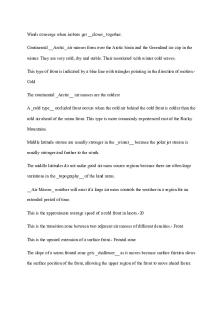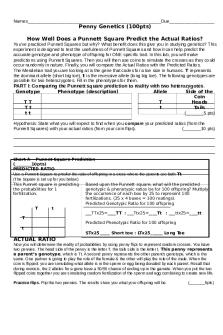Ch. 8 Bacterial Genetics PDF

| Title | Ch. 8 Bacterial Genetics |
|---|---|
| Course | General Microbiology |
| Institution | East Los Angeles College |
| Pages | 4 |
| File Size | 152.4 KB |
| File Type | |
| Total Downloads | 64 |
| Total Views | 154 |
Summary
Microbiology 20 Practice Exams...
Description
Practice test Chapter 8 Name___________________________________
MULTIPLE CHOICE. Choose the one alternative that best completes the statement or answers the question. 1) Which of the following is involved in translation? A) mRNA B) tRNA C) both mRNA and tRNA D) rRNA E) mRNA, rRNA and tRNA are all involved.
1)
2) Which of the following is a characteristic shared by DNA and RNA polymerases? A) dependence on helicase B) direction of polymerization C) speed D) efficiency of proofreading E) type of nucleotides used
2)
3) The AUG codon functions in coding for the amino acid methionine and as a A) termination signal. B) marker for introns. C) recognition site for RNA polymerase. D) start signal. E) "wobble" codon.
3)
4) Semiconservative DNA replication means that A) the cell can proofread its newly synthesized DNA only part of the time. B) each strand of a double -stranded DNA molecule is replicated differently. C) nucleotides are constantly being recycled as cells make DNA. D) each daughter DNA molecule is composed of one original strand and one new strand. E) the sequence of a DNA molecule is preserved as it is being replicated.
4)
5) Inducible operons A) usually require an activator to be transcribed. B) are generally catabolic pathways. C) usually require a repressor to be transcribed. D) are normally active. E) are active in the presence of a repressor.
5)
6) Which of the following are considered to be frameshift mutations? A) deletions B) insertions C) inversions D) both inversion and insertions E) both deletions and insertions
6)
1
7) Which of the following causes mutations by creating thymine dimers? A) ultraviolet light B) nitrous acid C) gamma rays D) nucleotide analogs E) benzopyrene
7)
8) Which of the following is a DNA repair enzyme activated by visible light? A) DNA photolyase B) DNA ligase C) primase D) transposase E) bacteriocin
8)
9) The Ames test proves that a chemical is A) carcinogenic in humans. B) mutagenic in Salmonella. C) carcinogenic in Salmonella. D) carcinogenic. E) mutagenic in humans.
9)
10) In conjugation, F + cells A) contain "jumping genes." B) can transfer DNA only to other F+ cells. C) do not have conjugation pili. D) serve as recipient cells. E) contain an F plasmid.
10)
11) A gene is best defined as A) A sequence of nucleotides in RNA that codes for a functional product. B) A transcribed unit of DNA. C) A segment of DNA. D) A sequence of nucleotides in DNA that codes for a functional product. E) Three nucleotides that code for an amino acid.
11)
12) Which of the following statements is false? A) The leading strand of DNA is made continuously. B) DNA polymerase joins nucleotides in one direction only. C) The lagging strand of DNA is started by an RNA primer. D) DNA replication proceeds in one direction around the bacterial chromosome. E) Multiple replication forks are possible on a bacterial chromosome.
12)
13) Transformation is the transfer of DNA from a donor to a recipient cell A) By sexual reproduction. B) As naked DNA in solution. C) By a bacteriophage. D) By cell-to-cell contact. E) By crossing over.
13)
2
14) Genetic change in bacteria can be brought about by A) Conjugation. B) Mutation. C) Transformation. D) Transduction. E) All of the above.
14)
15) Synthesis of a repressible enzyme is stopped by A) The allosteric transition. B) The corepressor binding to the operator. C) The substrate binding to the repressor. D) The corepressor-repressor binding to the operator. E) The end-product binding to the promoter.
15)
16) The damage caused by ultraviolet radiation is A) Repaired during transcription. B) Repaired during translation. C) Repaired by DNA replication. D) Never repaired. E) Cut out and replaced.
16)
17) In transcription, A) DNA is copied to RNA. B) DNA is changed to RNA. C) DNA is replicated. D) Proteins are made. E) RNA is copied to DNA.
17)
18) DNA helicases A) synthesize short DNA molecules important for the function of DNA polymerase. B) seal gaps between DNA fragments. C) break hydrogen bonds between complementary nucleotides. D) proofread DNA molecules. E) assist in recognition of promoters during transcription.
18)
TRUE/FALSE. Write 'T' if the statement is true and 'F' if the statement is false. 19) In generalized transduction, viruses carry random DNA sequences from one cell to another.
19)
20) DNA polymerase III participates in the dark repair mechanism of DNA mutation repair.
20)
3
Answer Key Testname: CHAPTER 8 PRACTICE TEST MICROBIOLOGY
1) 2) 3) 4) 5) 6) 7) 8) 9) 10) 11) 12) 13) 14) 15) 16) 17) 18) 19) 20)
E B D D B E A A B E D D B E D E A C TRUE FALSE
4...
Similar Free PDFs

Ch. 8 Bacterial Genetics
- 4 Pages

Chapter 09 Bacterial Genetics
- 19 Pages

Bacterial Genetics - Lecture notes 5
- 17 Pages

Genetics - Lecture notes 8
- 7 Pages

Group 8 Genetics LAB
- 29 Pages

Ch 8- Social Notes - ch 8
- 2 Pages

Vaginosis Bacterial
- 3 Pages

Bacterial Meningitis
- 2 Pages

Bacterial cytoskeleton
- 3 Pages

CH 8/ Lecture 8 ANSWERS
- 13 Pages

Ch 8 8 - chapter 8 module
- 4 Pages

Genetics Penny Genetics
- 4 Pages
Popular Institutions
- Tinajero National High School - Annex
- Politeknik Caltex Riau
- Yokohama City University
- SGT University
- University of Al-Qadisiyah
- Divine Word College of Vigan
- Techniek College Rotterdam
- Universidade de Santiago
- Universiti Teknologi MARA Cawangan Johor Kampus Pasir Gudang
- Poltekkes Kemenkes Yogyakarta
- Baguio City National High School
- Colegio san marcos
- preparatoria uno
- Centro de Bachillerato Tecnológico Industrial y de Servicios No. 107
- Dalian Maritime University
- Quang Trung Secondary School
- Colegio Tecnológico en Informática
- Corporación Regional de Educación Superior
- Grupo CEDVA
- Dar Al Uloom University
- Centro de Estudios Preuniversitarios de la Universidad Nacional de Ingeniería
- 上智大学
- Aakash International School, Nuna Majara
- San Felipe Neri Catholic School
- Kang Chiao International School - New Taipei City
- Misamis Occidental National High School
- Institución Educativa Escuela Normal Juan Ladrilleros
- Kolehiyo ng Pantukan
- Batanes State College
- Instituto Continental
- Sekolah Menengah Kejuruan Kesehatan Kaltara (Tarakan)
- Colegio de La Inmaculada Concepcion - Cebu



